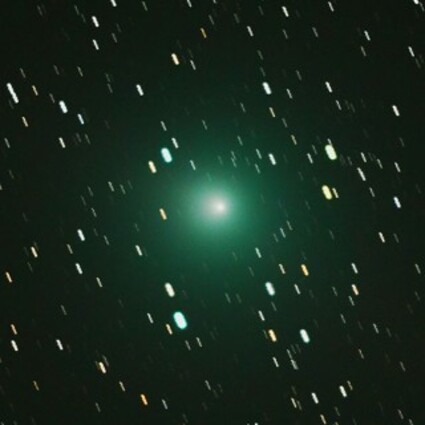Stars over Sisters
Last updated 12/31/2018 at Noon

a local photographer on December 13, 2018, three days before its closest approach to the earth. photo provided
This photo of comet Wirtanen was taken
As the world exercised the New Year's Eve tradition of bidding adieu to the old year and welcoming in a new one, many of us look forward to 2019 with the hope that it will be filled with joyful and uplifting experiences.
Indeed, some of these exciting events will take place in the night skies of January, such as a meteor shower, a lunar eclipse and great views of some bright planets. But first a backward glance to December 2018 is in order.
On December 16 comet 46P/Wirtanen, a member of the Jupiter family of comets, approached to within 7.2 million miles of the earth. In terms of astronomical distances, this is very close. In fact, it is one of 20 closest comets to pass by the earth since the ninth century.
Discovered by American astronomer Carl Wirtanen in 1948 from the Lick Observatory in California, it is a relatively small comet that currently has an orbital period of 5.4 years.
Although the comet is currently leaving the inner solar system, it likely will still be visible with a pair of binoculars through the first half of January, after which light from a brightening moon will interfere. Scan the area of sky about halfway between the bright star Capella in the constellation of Auriga and the northern-most star in the bowl of the Big Dipper.
The comet won't come close to the earth again for another 27 years.
The Quadrantids meteor shower will peak on the evening of January 3/morning of January 4 when perhaps 40 meteors per hour will streak across the sky. These meteors are produced from space dust left by an extinct comet called 2003 EH1. When traced backwards, the streaks of light appear to emanate from the northern part of Bootes, but can be seen all over the night sky. Feeble light from a thin crescent moon will not interfere with the viewing conditions.
A total lunar eclipse will occur on the evening of Sunday, January 20. During this event, the moon will pass completely through the earth's shadow. As a result, the moon will gradually get darker before turning a red hue. The eclipse will be visible through all of North America and will peak at about 9:12 p.m. But there's more. This will also be a supermoon eclipse, meaning the fully eclipsed moon will be about 15,000 miles closer to the earth than its average distance.
The moon will be new (dark) on January 5, which will make for ideal viewing conditions for this month's most prominent planets and deep-sky objects.
Conveniently, Venus will reach its greatest western elongation on January 6. This will be the optimal time to view it since it will be at its highest point above the horizon in the early morning sky. Venus and Jupiter will be in conjunction on January 22, appearing together in the morning sky.
Additionally, Mars can be spotted well above the southwestern horizon as night falls, and not setting until about 11 p.m. local time.
Another celestial object worth taking a look at this month is M45, also known as the "Pleiades" or "Seven Sisters." It is perhaps the finest and brightest open star cluster in the entire sky. M45 contains seven prominent stars that have a distinct blue color to them. It will be visible low in the eastern sky at nightfall, reaching its highest point in the sky at about 8:15 p.m., a full 70 degrees above the southern horizon.
The Pleiades is an easy naked-eye object that can be found in the constellation of Taurus just above the bright star Aldebaran. The cluster is, in fact, so famous that the Subaru car company uses it as their design logo.
So grab a buddy, warm clothes and some hot cocoa and head outside to see these amazing events happening all month long.















Reader Comments(0)